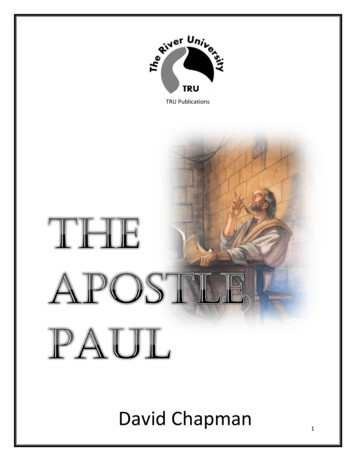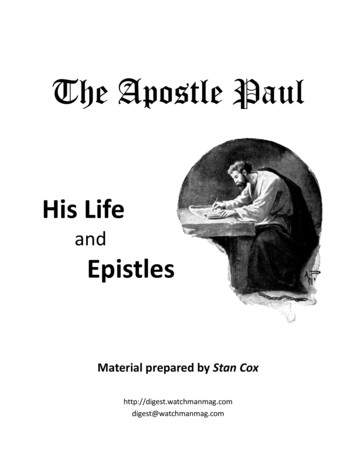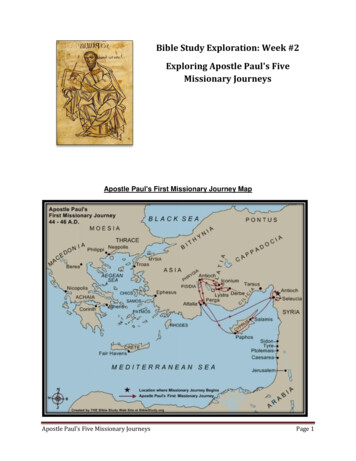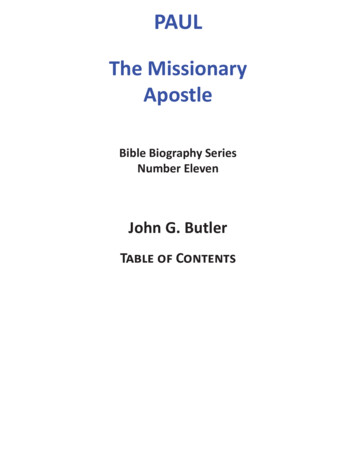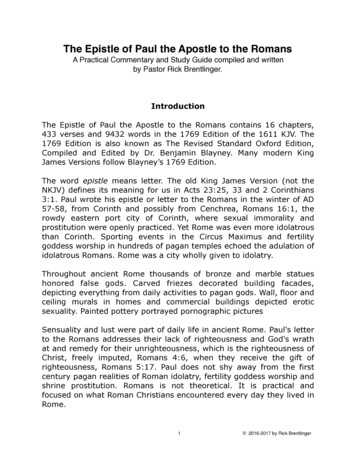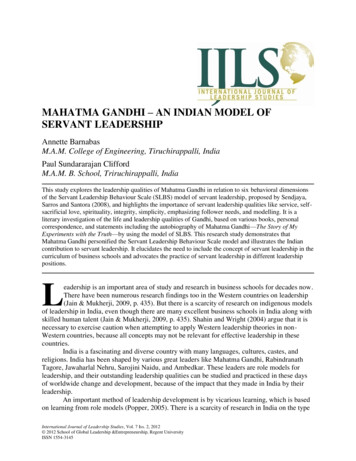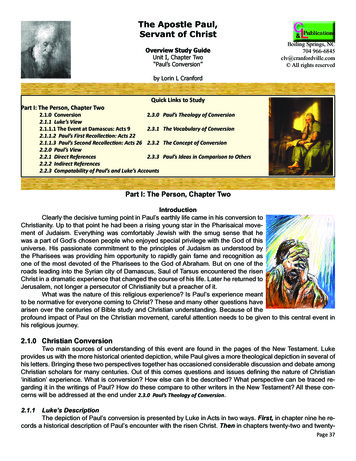
Transcription
The Apostle Paul,Servant of ChristOverview Study GuideUnit I, Chapter Two“Paul’s Conversion”Boiling Springs, NC704 966-6845clv@cranfordville.com All rights reservedby Lorin L CranfordPart I: The Person, Chapter TwoQuick Links to Study2.1.0 Conversion2.3.02.1.1 Luke’s View2.1.1.1 The Event at Damascus: Acts 92.3.12.1.1.2 Paul’s First Recollection: Acts 222.1.1.3 Paul’s Second Recollection: Acts 26 2.3.22.2.0 Paul’s View2.2.1 Direct References2.3.32.2.2 Indirect References2.2.3 Compatability of Paul’s and Luke’s AccountsPaul’s Theology of ConversionThe Vocabulary of ConversionThe Concept of ConversionPaul’s Ideas in Comparison to OthersPart I: The Person, Chapter TwoIntroductionClearly the decisive turning point in Paul’s earthly life came in his conversion toChristianity. Up to that point he had been a rising young star in the Pharisaical movement of Judaism. Everything was comfortably Jewish with the smug sense that hewas a part of God’s chosen people who enjoyed special privilege with the God of thisuniverse. His passionate commitment to the principles of Judaism as understood bythe Pharisees was providing him opportunity to rapidly gain fame and recognition asone of the most devoted of the Pharisees to the God of Abraham. But on one of theroads leading into the Syrian city of Damascus, Saul of Tarsus encountered the risenChrist in a dramatic experience that changed the course of his life. Later he returned toJerusalem, not longer a persecutor of Christianity but a preacher of it.What was the nature of this religious experience? Is Paul’s experience meantto be normative for everyone coming to Christ? These and many other questions havearisen over the centuries of Bible study and Christian understanding. Because of theprofound impact of Paul on the Christian movement, careful attention needs to be given to this central event inhis religious journey.2.1.0 Christian ConversionTwo main sources of understanding of this event are found in the pages of the New Testament. Lukeprovides us with the more historical oriented depiction, while Paul gives a more theological depiction in several ofhis letters. Bringing these two perspectives together has occasioned considerable discussion and debate amongChristian scholars for many centuries. Out of this comes questions and issues defining the nature of Christian‘initiation’ experience. What is conversion? How else can it be described? What perspective can be traced regarding it in the writings of Paul? How do these compare to other writers in the New Testament? All these concerns will be addressed at the end under 2.3.0 Paul’s Theology of Conversion.2.1.1Luke’s DescriptionThe depiction of Paul’s conversion is presented by Luke in Acts in two ways. First, in chapter nine he records a historical description of Paul’s encounter with the risen Christ. Then in chapters twenty-two and twentyPage 37
six, a recounting of the experience is placed in two defense speeches given by Paul before Jewish and government authorities after his arrest in Jerusalem.1 Do these three accounts in Acts harmonize with one another?What is the distinctive emphasis of each account? Why three accounts rather than just one? These and manyother questions have been raised over the years of careful study of these texts.So, let’s take a look at each of them first, and afterwards compare them with one another. There’s muchfor us to learn here.2.1.1.1 The Event at DamascusSecondary Source:Acts 9:1-19a1 Meanwhile Saul, still breathing threats and murder against the disciples of the Lord, went to the high priest 2and asked him for letters to the synagogues at Damascus, so that if he found any who belonged to the Way, menor women, he might bring them bound to Jerusalem. 3 Now as he was going along and approaching Damascus,suddenly a light from heaven flashed around him. 4 He fell to the ground and heard a voice saying to him, “Saul,Saul, why do you persecute me?” 5 He asked, “Who are you, Lord?” The reply came, “I am Jesus, whom you arepersecuting. 6 But get up and enter the city, and you will be told what you are to do.” 7 The men who were travelingwith him stood speechless because they heard the voice but saw no one. 8 Saul got up from the ground, and thoughhis eyes were open, he could see nothing; so they led him by the hand and brought him into Damascus.9 For three days he was without sight, and neither ate nor drank. 10 Now there was a disciple in Damascusnamed Ananias. The Lord said to him in a vision, “Ananias.” He answered, “Here I am, Lord.” 11 The Lord said tohim, “Get up and go to the street called Straight, and at the house of Judas look for a man of Tarsus named Saul.At this moment he is praying, 12 and he has seen in a vision a man named Ananias come in and lay his hands onhim so that he might regain his sight.” 13 But Ananias answered, “Lord, I have heard from many about this man,how much evil he has done to your saints in Jerusalem; 14 and here he has authority from the chief priests to bindall who invoke your name.” 15 But the Lord said to him, “Go, for he is an instrument whom I have chosen to bringmy name before Gentiles and kings and before the people of Israel; 16 I myself will show him how much he mustsuffer for the sake of my name.” 17 So Ananias went and entered the house. He laid his hands on Saul and said,“Brother Saul, the Lord Jesus, who appeared to you on your way here, has sent me so that you may regain yoursight and be filled with the Holy Spirit.” 18 And immediately something like scales fell from his eyes, and his sightwas restored. Then he got up and was baptized, 19 and after taking some food, he regained his strength.9.1 Ὁ δὲ Σαῦλος ἔτι ἐμπνέων ἀπειλῆς καὶ φόνου εἰς τοὺς μαθητὰς τοῦ κυρίου, προσελθὼν τῷ ἀρχιερεῖ 2ᾐτήσατο παρʼ αὐτοῦ ἐπιστολὰς εἰς Δαμασκὸν πρὸς τὰς συναγωγάς, ὅπως ἐάν τινας εὕρῃ τῆς ὁδοῦ ὄντας, ἄνδραςτε καὶ γυναῖκας, δεδεμένους ἀγάγῃ εἰς Ἰερουσαλήμ. 3 ἐν δὲ τῷ πορεύεσθαι ἐγένετο αὐτὸν ἐγγίζειν τῇ Δαμασκῷ,ἐξαίφνης τε αὐτὸν περιήστραψεν φῶς ἐκ τοῦ οὐρανοῦ, 4 καὶ πεσὼν ἐπὶ τὴν γῆν ἤκουσεν φωνὴν λέγουσαν αὐτῷΣαοὺλ Σαούλ, τί με διώκεις; 5 εἶπεν δέ· Τίς εἶ, κύριε; ὁ δέ· Ἐγώ εἰμι Ἰησοῦς ὃν σὺ διώκεις· 6 ἀλλὰ ἀνάστηθι καὶεἴσελθε εἰς τὴν πόλιν, καὶ λαληθήσεταί σοι ὅ τί σε δεῖ ποιεῖν. 7 οἱ δὲ ἄνδρες οἱ συνοδεύοντες αὐτῷ εἱστήκεισαν ἐνεοί,ἀκούοντες μὲν τῆς φωνῆς μηδένα δὲ θεωροῦντες. 8 ἠγέρθη δὲ Σαῦλος ἀπὸ τῆς γῆς, ἀνεῳγμένων δὲ τῶν ὀφθαλμῶναὐτοῦ οὐδὲν ἔβλεπεν· χειραγωγοῦντες δὲ αὐτὸν εἰσήγαγον εἰς Δαμασκόν. 9 καὶ ἦν ἡμέρας τρεῖς μὴ βλέπων, καὶ οὐκἔφαγεν οὐδὲ ἔπιεν.10 Ἦν δέ τις μαθητὴς ἐν Δαμασκῷ ὀνόματι Ἁνανίας, καὶ εἶπεν πρὸς αὐτὸν ἐν ὁράματι ὁ κύριος· Ἁνανία. ὁ δὲεἶπεν· Ἰδοὺ ἐγώ, κύριε. 11 ὁ δὲ κύριος πρὸς αὐτόν· Ἀναστὰς πορεύθητι ἐπὶ τὴν ῥύμην τὴν καλουμένην Εὐθεῖανκαὶ ζήτησον ἐν οἰκίᾳ Ἰούδα Σαῦλον ὀνόματι Ταρσέα, ἰδοὺ γὰρ προσεύχεται, 12 καὶ εἶδεν ἄνδρα ἐν ὁράματι Ἁνανίανὀνόματι εἰσελθόντα καὶ ἐπιθέντα αὐτῷ χεῖρας ὅπως ἀναβλέψῃ. 13 ἀπεκρίθη δὲ Ἁνανίας· Κύριε, ἤκουσα ἀπὸ πολλῶνπερὶ τοῦ ἀνδρὸς τούτου, ὅσα κακὰ τοῖς ἁγίοις σου ἐποίησεν ἐν Ἰερουσαλήμ· 14 καὶ ὧδε ἔχει ἐξουσίαν παρὰ τῶνἀρχιερέων δῆσαι πάντας τοὺς ἐπικαλουμένους τὸ ὄνομά σου. 15 εἶπεν δὲ πρὸς αὐτὸν ὁ κύριος· Πορεύου, ὅτισκεῦος ἐκλογῆς ἐστίν μοι οὗτος τοῦ βαστάσαι τὸ ὄνομά μου ἐνώπιον ἐθνῶν τε καὶ βασιλέων υἱῶν τε Ἰσραήλ, 16ἐγὼ γὰρ ὑποδείξω αὐτῷ ὅσα δεῖ αὐτὸν ὑπὲρ τοῦ ὀνόματός μου παθεῖν. 17 ἀπῆλθεν δὲ Ἁνανίας καὶ εἰσῆλθεν εἰς τὴνοἰκίαν, καὶ ἐπιθεὶς ἐπʼ αὐτὸν τὰς χεῖρας εἶπεν· Σαοὺλ ἀδελφέ, ὁ κύριος ἀπέσταλκέν με, Ἰησοῦς ὁ ὀφθείς σοι ἐν τῇὁδῷ ᾗ ἤρχου, ὅπως ἀναβλέψῃς καὶ πλησθῇς πνεύματος ἁγίου. 18 καὶ εὐθέως ἀπέπεσαν αὐτοῦ ἀπὸ τῶν ὀφθαλμῶνὡς λεπίδες, ἀνέβλεψέν τε καὶ ἀναστὰς ἐβαπτίσθη, 19 καὶ λαβὼν τροφὴν ἐνίσχυσεν.“The narrative of Saul’s conversion is strategically placed between the mass conversion of the Samaritans and the conversionof the first Gentiles (cf. 10:45; 11:18). In contrast to the pious and open-minded Ethiopian who was an ideal candidate for conversion,Saul was furiously ‘opposing God’ (5:39) and ‘breathing threats and murder against the disciples of the Lord’ (9:1). This unlikely candidate for conversion would become the Lord’s chosen instrument, not by his own volition but by the gracious will of Christ; he alsowould assume an ever-increasing role in Acts. The importance of Saul’s conversion is highlighted by Luke, who tells it three times: inchap. 9 in the form of a narrative, in 22:4–16 and 26:9–18 in the form of autobiographical reports by Paul.” [Gerhard A. Krodel, Acts,Augsburg Commentary on the New Testament (Minneapolis, MN: Augsburg Publishing House, 1986), 171-72.]Page 381
A helpful way of getting into a historically oriented text is through the use of some of the techniques of‘Narrative Criticism,’2 which is a more recently developed literary method of reading ancient texts, especially historically oriented biblical texts. We will adopt a very simplified version of this approach for our study of the Actstexts, not only to help us better understand the meaning of the passages, but it will also demonstrate how manybiblical scholars today are drawing upon modern techniques of literary analysis for Bible study. The analyticalelements that we will utilize are setting, characterization, and plotting. Some attention will also be given to scenedepiction and structure.3Setting. The narrative setting of a story centers on identification of scenesin the story, which are determined by identifying the place / time references and‘movements’ from one location to another as the story progresses. Very clearlythis narrative text has three ‘scenes’ with the third one divided into multiple segments.Scene 1: Jerusalem.Acts 9:1-2. 1 Meanwhile Saul, still breathing threats and murder against thedisciples of the Lord, went to the high priest 2 and asked him for letters to thesynagogues at Damascus, so that if he found any who belonged to the Way,men or women, he might bring them bound to Jerusalem.9.1 Ὁ δὲ Σαῦλος ἔτι ἐμπνέων ἀπειλῆς καὶ φόνου εἰς τοὺς μαθητὰς τοῦ κυρίου,προσελθὼν τῷ ἀρχιερεῖ 2 ᾐτήσατο παρʼ αὐτοῦ ἐπιστολὰς εἰς Δαμασκὸν πρὸςτὰς συναγωγάς, ὅπως ἐάν τινας εὕρῃ τῆς ὁδοῦ ὄντας, ἄνδρας τε καὶ γυναῖκας,δεδεμένους ἀγάγῃ εἰς Ἰερουσαλήμ.In verses one and two, the location mentioned here is the city of Jerusalem. Although not so identified directly, the action here took place at the residence of the high priest. Interest in Paul is resumed here, after mentioning himin passing in 7:58 and 8:1-358 Then they dragged him out of the city and began to stone him; and the witnesses laid their coats at the feet ofa young man named Saul.1 And Saul approved of their killing him. That day a severe persecution began against the church in Jerusalem,and all except the apostles were scattered throughout the countryside of Judea and Samaria. 2 Devout men buriedStephen and made loud lamentation over him. 3 But Saul was ravaging the church by entering house after house;dragging off both men and women, he committed them to prison.42During my years at Professor of New Testament and Greek at Southwestern Baptist Theological Seminary at Fort Worth, TexasI developed and taught a PhD seminar entitled “New Testament Critical Methodology.” In that year long doctoral seminar, the studentsexplored a wide variety of technical approaches to the study of the New Testament. We analyzed each approach from both historical andliterary perspectives in the fall semester, and then critically tested them out on specific New Testament texts in the spring semester. Outof that experience came much greater insights into various ways to gain understanding of the biblical texts.3The full blown procedure is much more detailed and complex than we can do here in our limited study. But with skill development as a part of the objective for the study guide, some exposure to this increasingly widely used technique is helpful. For moreexplanation of the methodology see Patrick E. Spencer’s comments at his blogg on “Gospels, Acts, and Hermeneutics” at gospelsandactshermeneutics.blogspot.com.Some awareness of writer / reader issues in narrative criticism is important. The term ‘implied author’ alludes to the writerof this story and who he was, along with what was happening, at the moment of composition of the story. Living human beings areconstantly changing along with their circumstances, but the writing of a story ‘freezes’ the author in the moment of composition. Thusintention, strategy in story telling etc. at that moment are a part of the analysis at a more technical level. This is related to but not thesame as identification of the historical author of a document.Another important term is ‘implied reader.’ The author of the story at the time of writing had in his mind a targeted audience; hewas telling the story to an audience that he envisioned to be the initial readers of the document. That readership in the author’s mind willdictate aspects of the telling of the story. He will include or exclude narrative details according to how much he thinks this readershipalready knows. On the other hand, the historical readers who include us today were not in the author’s mind because he knew nothingabout us. Often times tensions exist between the implied readers and the historical readers simply because the understanding of the circumstances behind the story is not the same, as well as interest in the details of the story.It sometimes is charted out as follows: HA / IA TEXT IR / HR, with the terms being historical author / implied author/implied reader / historical reader. The contribution of narrative criticism has largely been to sensitize the modern reader to many of theabove dynamics going on in the telling of a story by an ancient writer. This sensitivity then can help us better understand the story in thetext and to avoid drawing wrong conclusions about text meaning.4GNT: 8.1 Σαῦλος δὲ ἦν συνευδοκῶν τῇ ἀναιρέσει αὐτοῦ.Ἐγένετο δὲ ἐν ἐκείνῃ τῇ ἡμέρᾳ διωγμὸς μέγας ἐπὶ τὴν ἐκκλησίαν τὴν ἐν Ἱεροσολύμοις· πάντες δὲ διεσπάρησαν κατὰ τὰςPage 39
So we have a glimpse into this young Jewish Pharisee named Saul. He affirmed the execution of Stephen andbegan an ongoing, intensive persecution of Christians in the city of Jerusalem.5 This preview of Saul is necessaryfor understanding the point of scene one in 9:1-2. The length of time between Saul’s launching of the persecutionof believers in Jerusalem and his request to go to Damascus is not stated. Acts 8:4-40 shifts to the ministry ofPhilip at both Samaria and then in Gaza and finally from Azotus to Caesarea on the Mediterranean coast. SinceLuke has only minor interest in progression of time in his story, one should exercise great caution in projectingsome amount of time between Stephen’s death and the request to go to Damascus. It could have been a matter of weeks, months, and perhaps a year or more.6 The only indirect time reference in the text is the adverb ἔτι,meaning ‘still,’ in verse one. This suggests that some amount of time had passed between Stephen’s death andthe request to the high priest. And also that Saul’s intense persecution of believers in Jerusalem had not diminished during that time.In scene 1, Luke describes Saul’s request for authorization papers from the high priest7 in Jerusalem thatwould enable him to arrest Christians in Damascus.8 Such papers were known as אגרא דאקר in the Hebrew.9Numerous logistical questions arise regarding this, in part because the legal jurisdiction of the high priest wouldχώρας τῆς Ἰουδαίας καὶ Σαμαρείας πλὴν τῶν ἀποστόλων. 2 συνεκόμισαν δὲ τὸν Στέφανον ἄνδρες εὐλαβεῖς καὶ ἐποίησαν κοπετὸν μέγανἐπʼ αὐτῷ. 3 Σαῦλος δὲ ἐλυμαίνετο τὴν ἐκκλησίαν κατὰ τοὺς οἴκους εἰσπορευόμενος, σύρων τε ἄνδρας καὶ γυναῖκας παρεδίδου εἰςφυλακήν.5In a subsequent depictions of this by Luke, Paul in a speech to Agrippa makes the following claim:Acts 22:4-5, 4 I persecuted this Way up to the point of death by binding both men and women and putting them in prison, 5 asthe high priest and the whole council of elders can testify about me. From them I also received letters to the brothers in Damascus, andI went there in order to bind those who were there and to bring them back to Jerusalem for punishment.Acts 26:9-11, 9 Indeed, I myself was convinced that I ought to do many things against the name of Jesus of Nazareth. 10 Andthat is what I did in Jerusalem; with authority received from the chief priests, I not only locked up many of the saints in prison, but I alsocast my vote against them when they were being condemned to death. 11 By punishing them often in all the synagogues I tried to forcethem to blaspheme; and since I was so furiously enraged at them, I pursued them even to foreign cities.6Estimations can be produced from an overarching chronological projection of Paul’s life, which we will attempt at the end ofchapter three. But these remain only estimations and are without precise detail. The conversion of Paul (Acts 9) took place anywherefrom one to five years after the ascension of Jesus (Acts 1). Thus sometime between 31 and 35 AD is the larger possible time frame forthis segment from Stephen’s death to Paul’s departure for Damascus. But how long between these two events cannot be determinedclearly.7“HIGH PRIEST One in charge of the temple (or tabernacle) worship. A number of terms are used to refer to the high priest:the priest (Exod. 31:10); the anointed priest (Lev. 4:3); the priest who is chief among his brethren (Lev. 21:10); chief priest (2 Chron.26:20); and high priest (2 Kings 12:10).“Responsibilities and Privileges The high priesthood was a hereditary office based on descent from Aaron (Exod. 29:29–30;Lev. 16:32). Normally, the high priest served for life (Num. 18:7; 25:11–13; 35:25, 28; Neh. 12:10–11), though as early as Solomon’sreign a high priest was dismissed for political reasons (1 Kings 2:27).In the period before the Maccabean revolt the high priesthood became increasingly political. Jason, a Hellenistic sympathizer, oustedhis more conservative brother Onias III (2 Macc. 4:7–10, 18–20). Jason was, in turn, ousted by the more radically Hellenistic Menelauswho offered the Seleucid rulers an even larger bribe to secure the office (2 Macc. 4:23–26). With Menelaus the high priesthood passedout of the legitimate Zadokite line.“The Maccabees combined the office of high priest with that of military commander or political leader. Alexander Balas, acontender for the Seleucid throne, appointed Jonathan Maccabee “high priest” and “king’s friend” (1 Macc. 10:20). Simon Maccabeewas, likewise, confirmed in his high priesthood and made a “friend” of the Seleucid King Demetrius II (1 Macc. 14:38). Temple and statewere combined in the person of Simon who was both high priest and ethnarch (1 Macc. 15:1–2).“The Romans continued the practice of rewarding the high priesthood to political favorites. During the Roman period, Annas(high priest A.D. 6–15) was clearly the most powerful priestly figure. Even when deposed by the Romans, Annas succeeded in havingfive of his sons and a son-in-law, Joseph Caiaphas (high priest A.D. 18–36/37) appointed high priests. Some confusion has resulted fromNT references to the joint high priesthood of Annas and Caiaphas (Luke 3:2). The passage is perhaps best understood as an acknowledgment of Annas as the power behind his immediate successors. Another possibility is that Annas retained the title of respect on thegrounds that the high priesthood was for life. Ananias, one of Annas’ sons, was the high priest to whom Paul was brought in Acts 23:2;24:1.”[Chad Brand, Charles Draper, Archie England et al., Holman Illustrated Bible Dictionary (Nashville, TN: Holman Bible Publishers, 2003), 762 - 764.]8The high priest at this point in time was Joseph son of Caiaphas (Καϊάφας) who served as high priest from 18 to 36 AD. He hadpresided over the trial of Jesus. Caiaphas was the son-in-law of Annas by marriage to his daughter and ruled longer than any high priestin New Testament times. Caiaphas’ term in office was recorded by the first-century Jewish historian Josephus. He was appointed in AD18 by the Roman prefect who preceded Pilate, Valerius Gratus.9Evidently this was something similar to what Paul mentions in 2 Cor. 3:1, “Are we beginning to commend ourselves again?Surely we do not need, as some do, letters of recommendation (συστατικῶν ἐπιστολῶν) to you or from you, do we?”Page 40
have been limited to Judea, and Damascus was in the Roman province of Syria, some 135 miles to the northeastof Jerusalem.10 The best assumption from the very limited information available is that such authorization wouldhave been a letter commending Saul in his persecution of believers as having the full support of the high priest inJerusalem and also a request that local synagogue leaders11 cooperate fully with Saul in arresting the unrecanting Christians so they could be brought back to Jerusalem, as Luke states.Luke’s words imply that such authorization was given to Saul without delay or difficulty. This enabled himto make the several day journey from Jerusalem to Damascus to carry out his plans.Of particular interest is Luke’s characterization of the believing community as τῆς ὁδοῦ ὄντες, “being ofthe Way.” This is a favorite label for Christians throughout Acts, as 19:9, 23; 22:4; 24:14, 22; and 16:17; 18:25, 26reflect. The term in figurative use, as here, implies a philosophical group, which would have been typical terminology for such in the ancient world. As a religious group label, the closest parallel comes from the literature ofQumran where the idea, as expressed in Aramaic, is a frequent label for the groups located near the Dead Sea.12The term specifies that a group is traveling together on a well defined path through life. Whether these believersin Damascus were native Jews of the city, or whether they had fled from Jerusalem as a consequence of thepersecution of Saul mentioned in 8:1-3 is not clear. Probably both were included in the group.Scene 2: Road leading to Damascus.Acts 9:3-8. 3 Now as he was going along and approaching Damascus, suddenly alight from heaven flashed around him. 4 He fell to the ground and heard a voice saying to him, “Saul, Saul, why do you persecute me?” 5 He asked, “Who are you, Lord?”The reply came, “I am Jesus, whom you are persecuting. 6 But get up and enter thecity, and you will be told what you are to do.” 7 The men who were traveling with himstood speechless because they heard the voice but saw no one. 8 Saul got up fromthe ground, and though his eyes were open, he could see nothing; so they led him bythe hand and brought him into Damascus.3 ἐν δὲ τῷ πορεύεσθαι ἐγένετο αὐτὸν ἐγγίζειν τῇ Δαμασκῷ, ἐξαίφνης τε αὐτὸνπεριήστραψεν φῶς ἐκ τοῦ οὐρανοῦ, 4 καὶ πεσὼν ἐπὶ τὴν γῆν ἤκουσεν φωνὴν λέγουσαναὐτῷ Σαοὺλ Σαούλ, τί με διώκεις; 5 εἶπεν δέ· Τίς εἶ, κύριε; ὁ δέ· Ἐγώ εἰμι Ἰησοῦς ὃνσὺ διώκεις· 6 ἀλλὰ ἀνάστηθι καὶ εἴσελθε εἰς τὴν πόλιν, καὶ λαληθήσεταί σοι ὅ τί σε δεῖ“To issue such letters would presuppose authority on the part of the High Priest to require, or at least request, action by localJewish communities in territory outside Palestine and under a different civil government. Whether such authority existed and, if it did,how it was exercised cannot be determined with certainty. 1 Macc. 15:16–21, a letter from the Roman Consul Lucius to Ptolemy ofEgypt, seems to supply a precedent: it requires support for the Jews and adds ‘if any pestilent men have fled to you from their country,παράδοτε αὐτοὺς Σιμωνὶ τῷ ἀρχιερεῖ, ὅπως ἐκδικήσῃ αὐτοὺς κατὰ τὸν νόμον αὐτῶν.’ The same letter was sent, according to 1 Macc.15:22, 23, to a variety of destinations. Josephus does not mention this letter, which, if written by the Consul Lucius Caecilius Metellus,must have been sent to Ptolemy VIII ( Euergetes II, 145–116 BC) and be dated in 142 BC, but does refer (Ant. 14:145) to a decreeinitiated by ‘Lucius Valerius, son of Lucius, the praetor (στρατηγός; the Latin VS has consul)’. This refers to Numenius, an envoy ofthe Jews; a similar reference to ‘Numenius and his party’ in 1 Macc. 15:15 strongly suggests that though Josephus places his decree inthe time of Hyrcanus (if Hyrcanus I, probably c. 139 BC, if Hyrcanus II, c. 47 BC; see NS 1:195–7) both passages refer to the same decree. This gives the decree double attestation, but also diminishes our confidence in its dating and in its content, for the decree given byJosephus contains no reference to the right of extradition. In any case the latest date to which the decree can be assigned (if it ever wasenacted) is about eighty years before the time of Saul, and there can be no certainty that such an arrangement would remain in force forso long in very disturbed times. There is moreover a contradictory piece of evidence in Josephus, War 1:474 (‘No other sovereign hadbeen empowered by Caesar, as he [Herod] had, to reclaim a fugitive subject even from a state outside his jurisdiction’). Further, the evidence we have considered deals with relations between Jews and Romans. Any value it may possess will apply to the present case onlyif at the time in question Damascus was under Roman rule. This may have been so, but there is some ground for thinking that it was not;see on 9:23–25. It is however unnecessary to suppose that Paul’s actions carried, or needed, any authority beyond the confines of Judaism. Given the good will of the synagogues in Damascus it would be quite possible for Jews known to be Christians to ‘disappear’ (ourown age is familiar with the phenomenon, and the word) and subsequently to find themselves in unwelcome circumstances in Jerusalem.The important historical question is that of the relation between the High Priest and Sanhedrin and provincial synagogues. It is unfortunately a question to which no precise answer can be given. ‘The extent to which Jews outside Judea were willing to obey the orders ofthe Sanhedrin always depended on how far they were favourably disposed towards it. It was only within the limits of Judea proper thatit exercised direct power’ (NS 2:218). Known compliance with the policy of the Sanhedrin may have been a reason contributory to thechoice of Damascus as a place in which to pursue anti-Christian action.” [C. K. Barrett, A Critical and Exegetical Commentary on theActs of the Apostles, The International Critical Commentary on the Holy Scriptures of the Old and New Testaments (Edinburgh: T&TClark., 2004), 446-47.]11That a large Jewish population existed in Damascus at this time is evident from the Jewish historical Josephus who mentionsthe killing of some 18,000 Jews in the city by non-Jewish inhabitants there at an earlier time. (cf. Jewish Wars 2:561, 7:368, 2:560).12For details see CD 20:18; 1:13; 2:6; 1 QS 9:17, 18; 10:21; 11:13; 8:12-15 etc.Page 4110
ποιεῖν. 7 οἱ δὲ ἄνδρες οἱ συνοδεύοντες αὐτῷ εἱστήκεισαν ἐνεοί, ἀκούοντες μὲν τῆς φωνῆς μηδένα δὲ θεωροῦντες.8 ἠγέρθη δὲ Σαῦλος ἀπὸ τῆς γῆς, ἀνεῳγμένων δὲ τῶν ὀφθαλμῶν αὐτοῦ οὐδὲν ἔβλεπεν· χειραγωγοῦντες δὲ αὐτὸνεἰσήγαγον εἰς Δαμασκόν.In verses three through nine, the second scene takes place. The location is undefined beyond being ona road that went to the city of Damascus and was not very far from the city.13 But we do not know the exact spotwhere Saul met the risen Christ. The characters14 in this scene are Paul, the risen Christ, and the men who wereaccompanying Paul from Jerusalem to Damascus. The focus is on the interaction between Christ and Paul in thevisionary experience. The traveling companions play a secondary role.The scene begins with the flashing of a light from Heaven around Paul: ἐξαίφνης τεαὐτὸν περιήστραψεν φῶς ἐκ τοῦ οὐρανοῦ. The impact of this is that Paul fell to the ground.And then a voice was heard calling out to Paul: καὶ πεσὼν ἐπὶ τὴν γῆν ἤκουσεν φωνὴνλέγουσαν αὐτῷ. The question put to Paul by the voice was simply: Σαοὺλ Σαούλ, τί μεδιώκεις; Not understanding who the voice was, Paul then responded with a question: Τίςεἶ, κύριε; Then the voice replied by identifying itself and gave Paul instructions on whatto do next: Ἐγώ εἰμι Ἰησοῦς ὃν σὺ διώκεις· ἀλλὰ ἀνάστηθι καὶ εἴσελθε εἰς τὴν πόλιν, καὶλαληθήσεταί σοι ὅ τί σε δεῖ ποιεῖν.Luke notes that the traveling companions of Paul were speechless because ofhearing sound but not seeing anyone: οἱ δὲ ἄνδρες οἱ συνοδεύοντες αὐτῷ εἱστήκεισαν ἐνεοί, ἀκούοντες μὲντῆς φωνῆς μηδένα δὲ θεωροῦντες. They didn’t know what was happening. When Paul got back up from off theground, he realized that he was blinded so that he couldn’t see anything: ἠγέρθη δὲ Σαῦλος ἀπὸ τῆς γῆς, ἀνεῳγμένωνδὲ τῶν ὀφθαλμῶν αὐτοῦ οὐδὲν ἔβλεπεν. Consequently, the men led him into the city where for three days he couldn’tsee and didn’t eat or drink anything: χειραγωγοῦντες δὲ αὐτὸν εἰσήγαγον εἰς Δαμασκόν. καὶ ἦν ἡμέρας τρεῖς μὴβλέπων, καὶ οὐκ ἔφαγεν οὐδὲ ἔπιεν.The narration of the event raises some issues needing explanation. The natural phenomena of light, lightening and fire are traditional motifs of a theophany15 (cf. Ezek. 1:28; Acts 2:3). The bright light and a voice signalthe presence of the supernatural (cf. Acts 2:2-3). Why did Saul not instantly recognize who was speaking?16Clearly he was not accustomed to experiencing such things. As a persecutor of the followers of Christ, he certainly was not expecting to see and talk with the risen Christ. The natural events had knocked him to the ground,further disorienting him. And then the question posed to him carried an unexpected assumption: the risen Christwas so identified with His followers that to persecute them was to persecute Him. In this, Luke makes an important theological point: Christ, even from Heaven, so identifies Himself with His own people that to harm them is totry to hurt Him. In the promise to be with His followers in Matth 28:20, Christ certainly keeps His word and standsIn two speeches of Paul, other narrations of this are given by Luke in Acts:Acts 22:6-11, 6 While I was on my way and approaching Damascus, about noon a great light from heaven suddenly shone aboutme. 7 I fell to the ground and heard a vo
The Apostle Paul, Servant of Christ Overview Study Guide Unit I, Chapter Two “Paul’s Conversion” by Lorin L Cranford Quick Links to Study Part I: The Person, Chapter Two 2.1.0 Conversion 2.3.0 Paul’s Theology of Conversion 2.1.1 Luke’s View 2.1.1.1 The Eve

